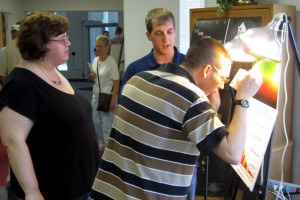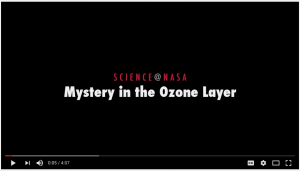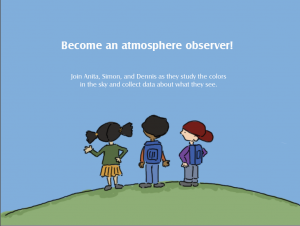Celebrate the SAGE III/ISS Launch!
Plan your own launch celebration with these resources and watch live on NASA TV as SAGE III soars to its place on the International Space Station.
Host an Event!
- Plan your event using easy-to-follow steps
- Join the online conversation
- Educate with hands-on activities
- Promote your launch celebration
There are activities in the launch kit to make your event fun for all ages. Be creative with your celebration and invite your friends or people from your community. Watch the launch and launch events live, including talks from NASA scientists and engineers. You don’t need to be at launch to have a great time. Everything you need to host a great event and join in the launch fun is here at your fingertips.
Watch the SAGE III/ISS Launch
Tune in to NASA TV to watch the launch and press conferences. The launch is currently scheduled for November 11th, 2016, but please continue to check this website and social media for potential updates as the launch draws closer.
Join the Online Discussion
Stay up to date on the latest SAGE III/ISS news and connect with us by following us on Facebook
- “Like” us on Facebook
Give a Talk About SAGE III/ISS
Use the resources below, and other resources on this website, to educate people about the Stratospheric Aerosol and Gas Experiment mission and its goals.
- A ready-to-go PowerPoint presentation that includes photos, videos, and talking points: Download Here
- Videos can be found here
Engage Participants in Hands-On Activities
- UV Bracelet Activity: The Earth’s ozone layer is one thing that helps protect humans from UV rays and SAGE III/ISS will be checking up on it. This activity explores radiation from the Sun and ways we can protect ourselves from these potentially harmful UV rays.
- Elementary GLOBE: SAGE III/ISS looks at how aerosols, or tiny particles, affect the air we breathe. The students in the Elementary GLOBE story, “What’s Up in the Atmosphere? Exploring Colors in the Sky” want to learn more about aerosols. In this activity, participants read the story and complete a series of four activities that explain there are particles in the air we breathe and they can impact sky color.
Middle
- Ozone: Good Up High, Bad Nearby: This lesson addresses the difference between good and bad ozone. During the activity, paricipants experience how difficult it is to accurately measure objects that are very small, like ozone molecules. SAGE III/ISS monitors “good” ozone in the stratosphere.
- Engineering Art in Science: Participants build a model of SAGE out of available materials and then conduct follow-on mission planning and news coverage.
- Have participants build a model SAGE III instrument (in cooperative pairs prior to launch) from available materials
- Materials: Foil, cardboard, glue, markers, scissors, tape, rulers, temper paint (optional)
- Ask participants to:
- Design a mission consisting of scientist, purpose, duration, and detailed budget
- Write a story as to what data was collected by their instrument
- Design a news segment to highlight the SAGE III mission to be videotaped and shared
- Have participants build a model SAGE III instrument (in cooperative pairs prior to launch) from available materials
High
- Exploring Diffraction with a Spectroscope: Participants build their own spectroscope from cardboard and will be able to see what happens to light when it passes through a spectroscope. The SAGE III/ISS instrument is a grating spectrometer that measures ultraviolet/visible energy.
- Careers in STEM – Engineering: In this activity STEM careers are explored through writing exercises using the diverse SAGE III/ISS team as an example.
- Writing Task: Visit the link below and pick three team members. Research the essential skills needed to qualify for their careers (high school math, science, university credits, masters, doctorate, internship, etc..). Write a brief abstract about each of them

- Read and discuss the article from the link below
- SAGE III/ISS to Study Earth’s Ozone Layer from the Space Station
- Discussion Questions:
- 1. What skills might be needed to perform the job of studying’ Earth’s ozone layer?
- 2. With what other professionals would it be beneficial for scientists or engineers to network?
- Writing Task: Visit the link below and pick three team members. Research the essential skills needed to qualify for their careers (high school math, science, university credits, masters, doctorate, internship, etc..). Write a brief abstract about each of them
Learn More
- Mission Brochure: http://eospso.nasa.gov/sites/default/files/publications/SAGE-III_missionBrochure_508.pdf
- Fact Sheet: https://sage.nasa.gov/wp/wp-content/uploads/2015/06/SAGE_III_litho_Ver5_wPub.pdf
- Earth Observer article: https://sage.nasa.gov/wp/wp-content/uploads/2015/06/SAGE.pdf
- Partners Lithograph: https://sage.nasa.gov/wp/wp-content/uploads/2015/06/SAGEIII_Intl_Collaboration.pdf
Watch Videos
- Trailer: https://www.youtube.com/watch?v=Jb4nyRowYHU
- Overview: https://sage.nasa.gov/sage-iiiiss-video
- eClips “Our World” (Grades K-5): https://www.youtube.com/watch?v=S5r-aGuraTk
- eClips “Real World” (Grades 6-8): https://www.youtube.com/watch?v=NcKr_77YFFM
- eClips “Launchpad” (Grades 9-12): https://www.youtube.com/watch?v=S5r-aGuraTk
- Ozone Layer Danger: https://www.youtube.com/watch?v=XLY8m-dXOxo
- NASA Sciencecast: https://www.youtube.com/watch?v=rq9EAHyHtu8&feature=youtu.be

Invite Local Speakers
- Earth Scientists: Contact your local university atmospheric science departments
- Climate Scientists: Contact your local university’s natural resource department
- Educators/Teachers: Contact science teachers at your local school


